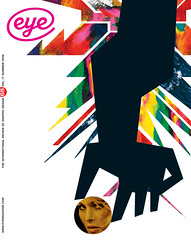Summer 2008
Googling the design canon
In the late 1980s, US designer and historian Martha Scotford set out on a mission to discover what might constitute a canon of graphic design …

through the relative weight of the graphic work shown in five books, including Meggs’ History.
She looked at the weight of each designer’s entry by measuring and counting the images reproduced, and used this research for her article ‘Is There a Canon of Graphic Design?’ (AIGA Journal of Design, vol. 9, no. 2, 1991, reprinted in Design Culture, ed. Steven Heller and Marie Finamore, 1997). Now, in this short commentary, Martha revisits her theme in the light of figures that Eye derived by Googling a ‘design canon’ which adds 30 new names to the 63 in Martha’s original list.
When I researched my 1991 article by counting images, I claimed that the authors of the five books involved had unintentionally created a canon. Moving the activity to the internet results in little agreement. From books we get facts, descriptions, interpretations, insights, specifically chosen images, and text read and edited by someone with an education.
On the internet, however, we get images, texts (well, words) written by who knows, produced for what purpose? Books are published to inform, to persuade and to delight. The web is the perfect confluence of misinformation, disinformation and useless information: words and images that are seldom reviewed by anyone other than the writer / creator of the site. Much is opinion and self-expression, rather than trustworthy information.
To combat ‘web naivety’, I give an assignment in my history of graphic design class (where Wikipedia and other quick-search sites are forbidden), by asking the student to choose a designer from a list (my ‘canon’), and to research that person on the web. The questions they should ask are: Who is writing? What are the writer’s credentials or associations? Who or what is responsible for the website? Do the various websites agree about certain facts? Does this add credibility or suggest the same, possibly wrong, sources? What is the primary purpose of the website – academic, commercial, self-promotional?
If you look at the top twenty names revealed by Eye’s search, only El Lissitzky and Toulouse-Lautrec appear from my original ‘canon’ (the other six names were Bayer, Cassandre, Lissitzky, Matter, Moholy-Nagy, Müller-Brockmann and Zwart.) So, hurrah for the Constructivists (tough, Modern, political); and everyone loves a dancer-singer poster.
Putting aside the flaws inherent in the project, some explanations come to mind: many designers are (or were) also artists; Art Nouveau has many fans (Mucha); posters are popular; Surrealism and photography have many followers (Man Ray); for some, the 1960s will never end (Peter Max); connections to movies are good (Marjane Satrapi); and the Web is the perfect index of what is new, hip and transitory.
From a book you can get a cohesive design history; from the web, never. But there is no turning back. While books and journals will continue to be important repositories, appreciated for their credibility, capacity and user experience, the web will increase in volume and in usage.
So Web users need to be more critical and demanding. Suppliers of web content should be held to higher standards. Writers should make no distinction between print and web distribution in their use of citations. Institutions, businesses, publications and others who seek respect must demonstrate credibility. Universities can make rules for their students’ work; scholars can be scrupulous. Schoolchildren’s web lessons should include the topic ‘credibility’.
So take note, students – or anyone searching the web. There are wonderful archives and many responsible organisations, institutions and businesses, but there’s also a huge amount of selling and promoting, and certainly too many enthusiasts with too little credibility. Be careful out there, people.
Martha Scotford, writer, lecturer, University of North Carolina
First published in Eye no. 68 vol. 17 2008
Eye is the world’s most beautiful and collectable graphic design journal, published quarterly for professional designers, students and anyone interested in critical, informed writing about graphic design and visual culture. It is available from all good design bookshops and online at the Eye shop, where you can buy subscriptions and single issues.

